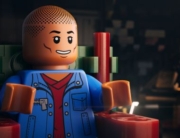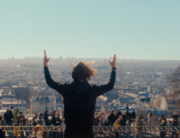
John Lennon and Yoko Ono’s appearance at the One to One benefit at Madison Square Garden on August 30, 1972, was the culmination of 18 months of their left-wing activism in New York City. Kevin Macdonald’s enlightening and frustrating documentary alternates between restored video footage and audio from Lennon’s final full-length live concert performance and archival clips from that era.
It opens with Lennon onstage singing “New York City” from his then-current album Sometime in New York City—the most explicitly political album of his solo career—followed by excerpts from a radio interview with the couple about their arrival in the city in early 1971, when they first moved into a small West Village apartment on Bank Street.
Macdonald intersperses original footage with scenes set in a re-created apartment, an interior standing in for the couple’s Village home, complete with the specific model of typewriter, records, books, and other ephemera. (The end credits reference the “Bank Street Reconstruction.”) A stream of contemporaneous programming unfolds on the television—the first fusillade includes the Attica prison riot, Richard Nixon at a White House gathering, Abbie Hoffman’s interview with Phil Donahue, the hit weekly drama The Waltons, and actual commercials. Macdonald uses these clips to provide political and cultural context for the duo’s activism, which was primarily antiwar. (The Vietnam War was about to be escalated by Nixon, whose promise to wind it down had gone by the wayside.)
As the well-chosen audio clips reveal, Lennon and Ono were interested in more than just Vietnam. During a phone call, Lennon speaks with promoter Allen Klein about going on a Free the People tour—performing in several cities and donating the proceeds to free local citizens who were languishing in jail because they couldn’t afford bail, an idea that anticipated current bail reform by several decades. Although that tour never materialized, the One to One benefit concert was held to help reform Willowbrook, a Staten Island school for mentally disabled children. The appalling conditions there had been exposed by TV news reporter Geraldo Rivera in a broadcast that Lennon and Ono, along with many other shocked New Yorkers, watched.
When they moved to the Village, Lennon and Ono befriended radicals like Hoffman and Jerry Rubin, who alerted them to legal injustices faced by academic Angela Davis and poet John Sinclair—both of whom are immortalized in eponymous songs on Sometime in New York City and appear briefly in the film. (Sinclair even receives a congratulatory call from John and Yoko after his early release from prison following a marijuana bust.)
Admittedly, Macdonald’s decision to make extensive use of vintage TV news clips sometimes feels like “throw it all against the wall and see what sticks,” as he includes people and events as disparate as Black congresswoman Shirley Chisholm running for president, racist Alabama governor George Wallace being shot at a Maryland campaign stop, the Brooklyn robbery that inspired Dog Day Afternoon, and all three networks’ coverage of the escalating war in Vietnam. Macdonald seems eager to reference as many notable names and occurrences as possible while creating the illusion of channel-surfing, but it overstuffs his 100-minute film. Similarly, the frequent returns to the reconstructed Bank Street apartment don’t add much—though they don’t particularly detract, either.
Then there’s the music. Macdonald takes these powerful performances and adds—yes—more vintage footage to comment on what was going on at the time, sometimes forcefully and other times in a more strained manner. John’s propulsive “Instant Karma” is paired with scenes of destruction in Vietnam and unrest at home. Yoko’s aching “Don’t Worry Kyoko,” about her young daughter from her first marriage, is accompanied by touching footage of Kyoko, John, and Yoko in happier times. John’s raucous heroin-habit anthem “Cold Turkey” includes glimpses of the 1972 Republican Convention, where Nixon was renominated en route to a historic landslide over Democratic candidate George McGovern. And the classic “Imagine” is overlaid with heart-tugging shots of Willowbrook children on an outing with caregivers.
Lennon fans will understandably quibble that no full-length versions of these songs are included in the film. Even the rousing finale, “Give Peace a Chance”—revved up by a joyful Stevie Wonder scat-singing over the familiar chorus—is only excerpted.






Leave A Comment